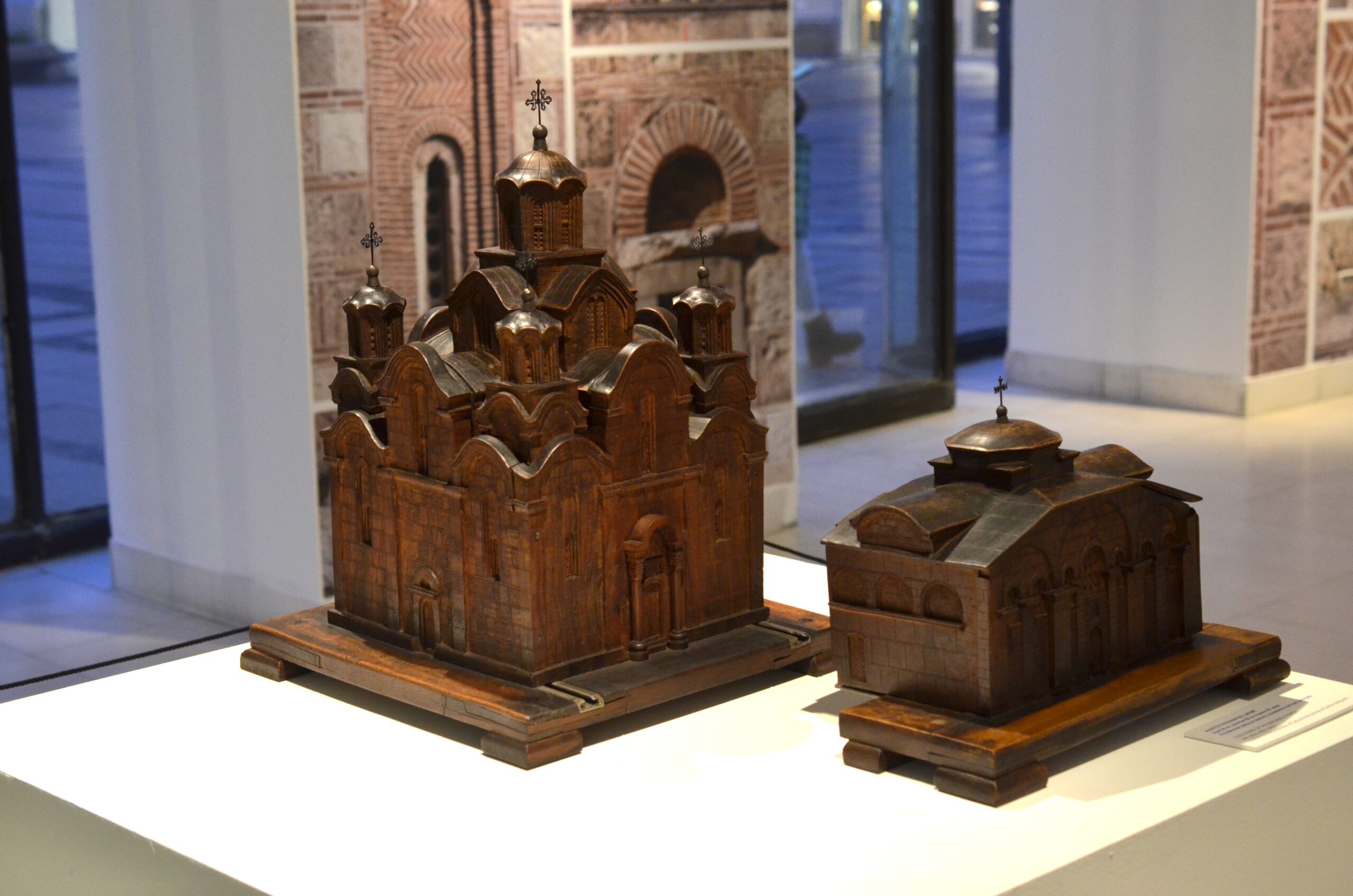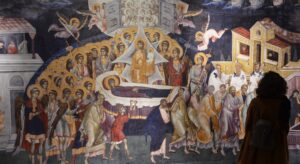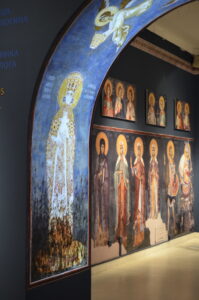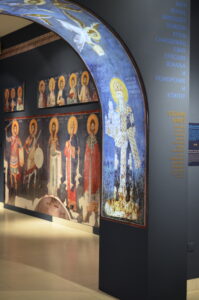
On December 21st, the exhibition dedicated to the great monastery of Gračanica was ceremonially opened. The project was also implemented for several reasons. Primarily, it’s purpose was the celebration of the completion of restoration works that have been continuously done since 2010 and have been completed in 2018. Secondly, 2021 was the year that marks the seven-hundred-year anniversary of the painting of the complete church interior. Finally, 2022 is the year in which the Institute for the Protection of Cultural Monuments of Serbia celebrated its 75 years of existence.
For all these reasons, the Gallery of Serbian Academy of Arts and Sciences provided the space and opened its doors to the wider public, art enthusiasts, as well as connoisseurs and admirers of religious heritage. The exhibition comes as a result of a two-year creation process, being suggested as a project for the first time in 2019. Due to the COVID – 19 pandemic and the schedule of other planned exhibitions, the celebration of Gračanica’s beauty and magnificence came to light by the end of 2022.
In search of wider context and answers, I have had the pleasure to meet with the author of the exhibition, Aleksandra Davidov Temerinski, who was of great help, and I am very delighted that she set aside some time to talk about and give more context to this wonderful exhibition dedicated to the medieval monument.
The three focal points of the exhibition revolve around the architecture, the paintings, and the process of conservation. Each segment has its own “part “of the exhibition, spatially and conceptually, ultimately leading to a 3D reconstruction of the monument within the Gallery. Described best by the words of the author of the exhibition, Aleksandra Davidov Temerisnki, which state that “since the beginning, there was intent to implement the exhibition in an associative order – hence the last part is the biggest, imitating the nave, along with the domes. And what I called the portraits, the associative element was more in accordance with the common practices in Western galleries and their contemporary presentation of medieval artefacts rather than imitating the space of the church. The narthex is reconstructed, the north and west wall, and it is done in the same manner as it is in the original space.” The exhibition truly attempts to bring the observer as close as possible to the real experience as if they were located within the monastery. With the aid of spiritual music, dimmed lights, and virtual reality, visitors could have an in-situ experience of the church’s interior, exterior and surroundings.

The entire conservation work was completed in 2018, ending an eight-year continuous process which resulted in the restoration of the complete church painting opus. We should bear in mind that the church is of bigger proportions, and, in comparison to other Serbian churches, the Gračanica is very well preserved, so it comes as no surprise that the restoration of the paintings lasted for a while. Moreover, the author expresses that what is even more important is that different conservators, especially when there is a chronological distance between them, implement different conservation techniques, so the final outcome is not harmonious and there is no unique methodological approach to the conservation process, which can cause confusion because the final presentation is different depending on when and by who it was done. In the case of Gračanica, this situation was avoided since the complete opus of the church was done continuously and by the same person. Finally, aside from the exhibition describing the importance of the monument on a local level, it emphasizes the overall importance of the monument for the studying of Byzantine architecture, being that Gračanica is the only example of a double inscribed cross in the plan of the church on the whole territory of the Byzantine Empire.
An important and essential aspect of the exhibition is expressed through the practice of new technology, in the view of virtual reality, architectural reconstruction through a special program, and the documentary film depicting the conservation process. With that in mind, the questions on whether these new practices raise awareness about religious heritage and provoke more engagement from the visitors, Aleksandra said the following: “ Well it is a source of information, and for the interested public, this information is everything. Especially when architecture is in question, but also for the other aspects of the exhibition. With the three so called films that we have provided, the public is given input about the building which is otherwise impossible to present. Not everything will be automatically clear, but there is the creation of an image that explains the degree of complexity of the architecture of this magnificent monument. The virtual reality, which is a vital element of the exhibition, would not be possible without the great help of the Blago foundation (Serbo-American foundation devoted to the preservation and promotion of Serbian cultural heritage), says Aleksandra. When discussing the conservation works, if the implementor of the works did not record on his own account, there would be no possibility of following the great process of conservation of the frescoes. He recorded his colleagues working, so you can also be given the sentiment that you are physically there, monitoring the works while they are being carried out, becoming a component of crucial importance for the further involvement of the viewers.


When answering questions regarding the satisfaction of the implementation and the possible outcomes of the exhibition, Davidov Temerinski stated that “the exhibition is quite visited, it is nicely covered by the media, and in that sense, I am very satisfied. But now, when mentioning the end of the exhibition, I personally consider that the exhibition should not end. In due time, since we have only two or three artefacts (the third one being the model of the church that is normally displayed here at the Institute), the exhibition is easily movable and could be easily transported to another venue to be exhibited. And something that I have been discussing with some of my colleagues is the awareness about the exhibition, which is somehow naturally imposed due to the small number of artefacts, so there would be no big expenses on the account of insurance for the artefacts. On the other hand, the exhibition is very popular and attractive to the public, so the possibility of displaying in other venues is something I am looking forward to.”
The exhibition finished on the 26th of February 2023, but it certainly does not mean that we have seen the last of the structural and aesthetic properties of the great Gračanica, which, thanks to the concepts and contemporary methods of presentation created for the exhibition, can easily travel across the country, region, and even the world.
Due to the time of the implementation of the exhibition, many voices from the public have expressed how the exhibition poses as a political tool in accordance with the current tensions between Kosovo and Serbia, being that the monument is located on the territory of Kosovo but is registered under the Serbian jurisdiction issued by UNESCO in 2006 as an addition to the previously inscribed group of monuments named “Medieval Monuments in Kosovo”.
One must take into consideration that when exhibitions devoted to religious monuments are being created, they are not intended to celebrate these monuments because of their geographical or national significance, but rather for their aesthetic and architectural properties, distinguishing them from the usual patterns of the period they were created in. For this reason, it should be emphasized that this exhibition is a result of a continuous project which lasted for almost a decade, and in no means was it intended to spark any political debate or to further deepen the political tensions which are building up among neighbours. On the contrary, Gračanica is a world known monastery recognized for its unique architectural solutions and is something that should be celebrated as a collective achievement in the area of European religious architecture.
Link to the conservation process of the monastery: https://www.sanu.ac.rs/wpcontent/videos/Virtuelne%20ture/gracanica/Gra%C4%8Danica%20Hronika%20konzervacije%20%C5%BEivopisa.mp4
By Jana Zarkovic, art historian and curatorial assistant at





Follow us: